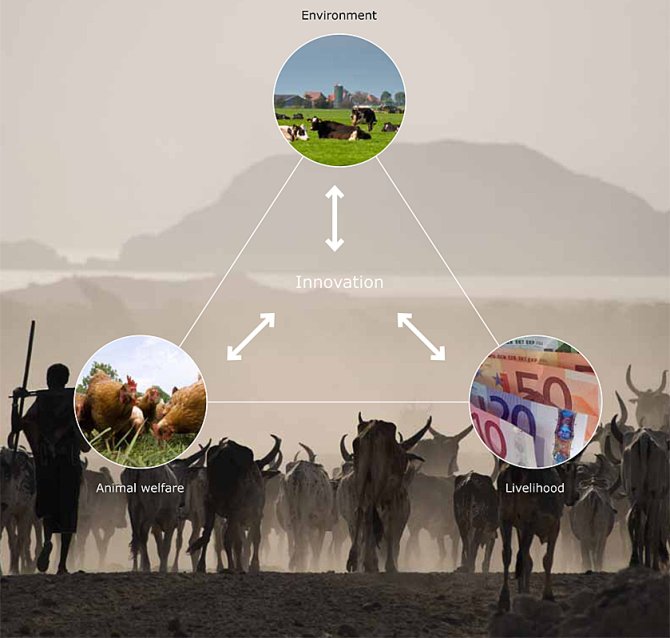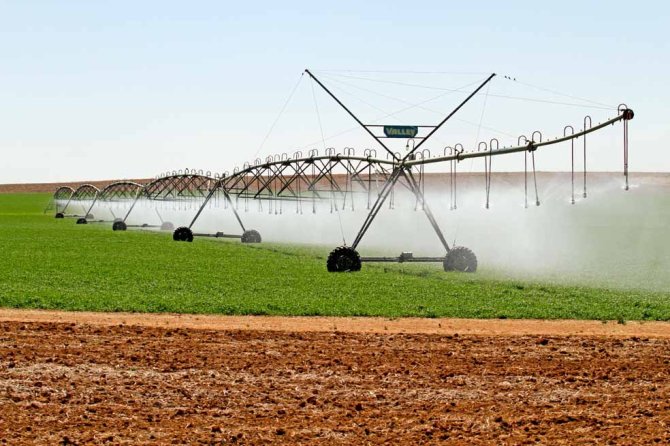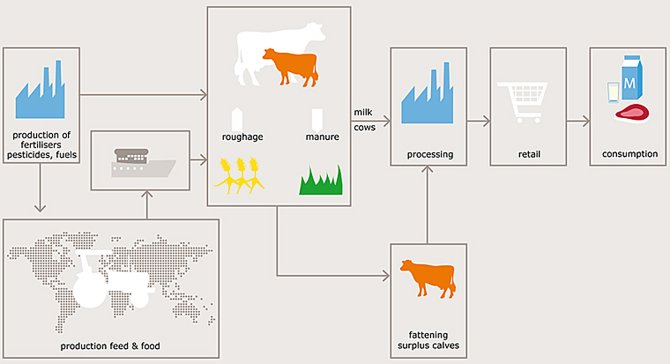Livestock
A multifaced issue like animal production cannot be resolved by simple answers as production systems should respect individual animals, make efficient use of natural resources, minimise (local) emissions into the environment and remain economically viable.
"Livestock production stands at a critical crossroad. The impact on the environment is considerable and society is increasingly concerned with issues such as animal welfare. As a result of growth of the global human population, rising incomes and urbanisation, the demand for food from animals is expected to double. Imke de Boer, professor of Animal Production Systems, is in her element in such discussions: “A transparent discussion requires a clear understanding of the impact of innovations on the diverse issues of sustainability.” De Boer's team studies the consequences of innovations in livestock systems across the world, with special focus on their impact on the environment, their impact on animal welfare and their impact on the livelihoods of farmers.
Reviewing the soil to supper chain: opportunities to re-define efficiency with focus on the environment, animal welfare and farmers livelihood
Their research provides insights into the possibility of designing systems that respect individual animals, make efficient use of natural resources, minimise (local) emissions into the environment and are economically viable. Such a multifaced issue like this cannot be resolved by simple answers; especially with regard to the global food supply. Goals that involve sustainability can be conflicting and the idyllic win-win situation is often unrealistic. A new housing system, for instance, can sometimes be profitable in one issue of sustainability but disadvantageous for others. The eventual choice for a system or innovation is tailor made and requires careful consideration of all the issues involved.

Organic milk
In the Netherlands, the pasturing of cows helps build a positive image of the dairy sector. It therefore has value, regardless of how important the pasturing is for the wellbeing of a cow or its effect on the environment. For a dairy cooperative it can be an important reason for stimulating farmers to allow their cows out to graze. The choice for organic milk also varies strongly between different countries. This more extensive form of milk production leads to a reduced local environmental impact (i.e. eutrophication per kg of milk and per ha of land), a lower or similar global impact (i.e. fossil energy use or global warming per kg. milk), but requires 40 percent more land per kilogram of milk. The percentage of organic milk in the total milk production of a country like Denmark, which has a low population density, is higher than in a densely populated country like the Netherlands. Where in one country land use is less relevant and the local impact of the organic production of milk can be kept relatively low, conventional milk production is a more logical option in other countries. This does mean, however, that it requires additional measures to limit the local environmental impact.


Re-define effiency
Traditionally, efficiency is defined at the level of the animal, e.g. how efficient does an animal use his or her feed. We should look at efficiency from a chain perspective. It has been shown that innovation at the ‘animal level’ does not always result in an improvement for the entire chain. For instance, if a cow is fed more maize silage than grass (silage), it will emit less methane (a major greenhouse gas) per kilogram of milk. But if taken into account that grassland will have to be converted into maize land, it turns out that the measure only becomes effective after around 45 years. From a chain perspective, extending the lifespan of a cow is a more effective strategy for reducing greenhouse gas emissions.
Although increasing the productivity per animal is useful in, say, pasture-based beef production systems in Central America, it is less desirable from a welfare perspective in intensive broiler production systems in the Netherlands. A smallholder in Sub-Saharan Africa benefits more from a measure that increases the survival rate of his stock, than from one which improves the productivity of his livestock. Livestock in smallholder systems often fulfil more functions than producing food alone, such as to provide manure or draught power for crop production or serving as a capital asset.
It is also important that whenever possible we avoid competition between humans and animals with regard to use of resources, such as land. Research in the UK has shown that pigs and chickens in particular eat more feed (in terms of protein and energy) which humans could eat themselves than the animals actually produce. This is not a sustainable situation. Livestock should preferably be fed products that are not suitable for human consumption, such as grass or waste streams from the industry. Integrating livestock production in cycles and valorising those waste streams, which are unsuitable for human consumption, provides an opportunity for a sustainable livestock sector."